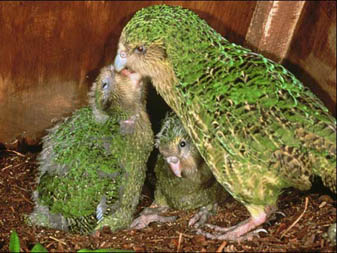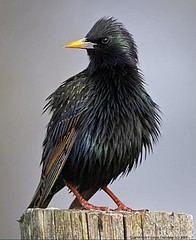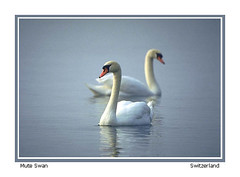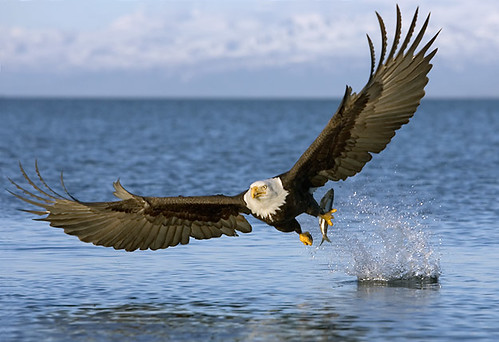Birds in Science
 A fossil of one adult Psittacosaurus dinosaur surrounded by 34 juveniles (pictured), has provided the most compelling evidence to date that dinosaurs raised their young after hatching. But what makes this 125-million-year old fossil find from Liaoning province more convincing is that the skeletons are complete, and crowded together in life-like positions with their legs tucked under and heads raised, indicating that they were buried alive rather than swept together after death. âIt looks like a creche,â says Chris Daniels, an evolutionary biologist at Adelaide University, Australia. âIt would be unlikely that one or two adults could provide food for so many youngsters.â
A fossil of one adult Psittacosaurus dinosaur surrounded by 34 juveniles (pictured), has provided the most compelling evidence to date that dinosaurs raised their young after hatching. But what makes this 125-million-year old fossil find from Liaoning province more convincing is that the skeletons are complete, and crowded together in life-like positions with their legs tucked under and heads raised, indicating that they were buried alive rather than swept together after death. âIt looks like a creche,â says Chris Daniels, an evolutionary biologist at Adelaide University, Australia. âIt would be unlikely that one or two adults could provide food for so many youngsters.â
People Hurting Birds
The birders of Europe need your help. The shooting of migratory birds on Malta has been a controversial topic for years. On the island of Malta, there is a âtraditionâ to shoot migratory birds as they cross the Mediterranean, despite the fact that many of the birds that are killed are protected, threatened or even endangered species. The toll is truly devastating, affecting birds from all over the continent, because Malta is one of the primary migration corridors for both raptors and passerines crossing the Mediterranean from Africa. There now is a petition to stop this senseless slaughter. Earlier this week, there were only 500 signatures on the online petition to stop the European Union from giving in to the government of Malta on bird shooting. It will only take one minute of your time to add your name to the online petition and to print out the text of this letter and mail it to EU Environment Commissioner Dimas (address provided on link). GrrlScientist says; It's amazing how an entire culture can act like zit-faced teen-aged boyz suffering from testosterone poisoning and refer to "tradition" as an adequate defense to continue their bad behavior, regardless of the consequences.
 Tricolored blackbird, Agelaius tricolor (pictured), numbers have been plummeting for decades but the federal government has failed to list them as endangered. The Center for Biological Diversity initially filed a petition with the U.S. Fish and Wildlife Service in 2004, asking for the bird to be listed under the federal Endangered Species Act. The agency's failure to act on this request for 16 months led to the federal lawsuit, which asks for emergency protection. The tricolored blackbird population declined from the millions in the 1930s to about 162,000 in 2000. The population has continued to drop as birds, deprived of their natural habitat by development and farming, attempt to nest among crops, where their nests are plowed over during harvest. âThey're getting hammered,â said Monica Bond, biologist for the Center.
Tricolored blackbird, Agelaius tricolor (pictured), numbers have been plummeting for decades but the federal government has failed to list them as endangered. The Center for Biological Diversity initially filed a petition with the U.S. Fish and Wildlife Service in 2004, asking for the bird to be listed under the federal Endangered Species Act. The agency's failure to act on this request for 16 months led to the federal lawsuit, which asks for emergency protection. The tricolored blackbird population declined from the millions in the 1930s to about 162,000 in 2000. The population has continued to drop as birds, deprived of their natural habitat by development and farming, attempt to nest among crops, where their nests are plowed over during harvest. âThey're getting hammered,â said Monica Bond, biologist for the Center.
 As thousands of pink-footed geese, Anser brachyrhynchus (pictured), prepare for their spring migration north to breeding grounds in the Arctic, ecologists are warning that the escalating conflict between farmers and the geese is threatening the birds' survival. Writing in the new issue of the British Ecological Society's Journal of Applied Ecology, Professor Marcel Klaassen of the Netherlands Institute of Ecology says that international action is urgently required. Together with colleagues in Denmark and Norway, Klaassen used data from ringed geese collected between 1991 and 2003 to model the impact of organised scaring of pink-footed geese. They found that any rapid escalation of bird scaring could be catastrophic for the birds, especially for less experienced individuals. "While conditions on the breeding grounds have generally remained unaffected by human activities, the staging and wintering grounds have undergone dramatic changes as a result of human development. As a result, most wintering populations have changed from feeding on natural or semi-natural habitats to agricultural land," Klaassen says.
As thousands of pink-footed geese, Anser brachyrhynchus (pictured), prepare for their spring migration north to breeding grounds in the Arctic, ecologists are warning that the escalating conflict between farmers and the geese is threatening the birds' survival. Writing in the new issue of the British Ecological Society's Journal of Applied Ecology, Professor Marcel Klaassen of the Netherlands Institute of Ecology says that international action is urgently required. Together with colleagues in Denmark and Norway, Klaassen used data from ringed geese collected between 1991 and 2003 to model the impact of organised scaring of pink-footed geese. They found that any rapid escalation of bird scaring could be catastrophic for the birds, especially for less experienced individuals. "While conditions on the breeding grounds have generally remained unaffected by human activities, the staging and wintering grounds have undergone dramatic changes as a result of human development. As a result, most wintering populations have changed from feeding on natural or semi-natural habitats to agricultural land," Klaassen says.
For those of you who thought that native peoples were kinder to wildlife than the European invaders were, well, think again. This sobering story provides a very different perspective of what people -- regardless of their skin color or cultural heritage -- do to birds and other wildlife when they have the opportunity. When explorers and pioneers visited California in the 1700s and early 1800s, they were astonished by the abundance of birds, elk, deer, marine mammals, and other wildlife they encountered. Biologists assumed that the abundant wildlife in California some 200 years ago had existed for thousands of years -- an assumption "that is ultimately used to make decisions about how to manage and conserve threatened or endangered species," says Jack Broughton, an associate professor of anthropology at the University of Utah. Broughton, an archeologist, thinks that birds and other wildlife rebounded only after early European explorers came into contact with natives, infecting them with fatal diseases such as smallpox, malaria, and influenza and killing off as much as 90 percent of the Indian population. In the light of these new data, writes John Faaborg, editor of Ornithological Monographs and a wildlife biology professor at the University of Missouri-Columbia, "We need to reconsider our impressions about human impacts on bird populations in the distant past. Jack Broughton makes an excellent case that native peoples living in the San Francisco Bay area harvested enough birds to deplete populations and even cause some local extinction, perhaps as long as 2,000 years ago."
People Helping Birds
 Peregrine falcons, Falco peregrinus (pictured), which nest near the Millennium Dome in London, UK, have been given their own security cameras due to concerns that their eggs were being stolen. The cameras have been installed at the nesting site on a tower block in Tower Hamlets, south-east London. Mr Gedge, of the London biodiversity partnership, explained that it was important for them to do all they could to ensure the birds flourished. "We're not too sure but we suspect there may have been some foul play, the birds may have been disturbed or some of the eggs taken," he said.
Peregrine falcons, Falco peregrinus (pictured), which nest near the Millennium Dome in London, UK, have been given their own security cameras due to concerns that their eggs were being stolen. The cameras have been installed at the nesting site on a tower block in Tower Hamlets, south-east London. Mr Gedge, of the London biodiversity partnership, explained that it was important for them to do all they could to ensure the birds flourished. "We're not too sure but we suspect there may have been some foul play, the birds may have been disturbed or some of the eggs taken," he said.
 Because the California Condor, Gymnogyps californianus, is one of the most endangered species on the planet, with only 273 of them alive today, all of them are special, but bird number 149 (pictured) is a very special animal. Bird 149 is a nine year-old female who has thrived in the wild since her release in the late 1990s, and she is also the mother of a wild condor: a healthy condor born in the wild is a rare and extraordinary event. However, last month, bird 149 and a three year-old male condor were captured in the Vermilion Cliffs area, northeast of the Grand Canyon. They are being treated at the Phoenix Zoo in Arizona for lead poisoning. "I get goose bumps when I work with them,â said zoo veterinarian Kathy Orr. âWhen they open their wings you just say âwow.â And then you realize there are only 270 of them in the whole world." These two birds will stay at the Phoenix Zoo where their handlers have a clear affection for an animal that could generously be described as ugly. âI think they are gorgeous,â said Logan. âFirst they are huge. They are one of those animals that just makes you say âwowâ when they spread their wings. And they are very intelligent.â GrrlScientist notes: I always thought that condors and vultures were ugly -- until I met them. I was lucky enough to meet several California Condors behind the scenes .. I stood no more than three feet away from two of them, in fact, when I visited the LA Zoo. I can tell you from that one experience that they are absolutely breathtaking and, due to their careful and considered gaze, they certainly have the appearance of an amazing intelligence. I can only pretend to imagine what a tremendous source of joy and pride it must be to work with these stunning birds every day.
Because the California Condor, Gymnogyps californianus, is one of the most endangered species on the planet, with only 273 of them alive today, all of them are special, but bird number 149 (pictured) is a very special animal. Bird 149 is a nine year-old female who has thrived in the wild since her release in the late 1990s, and she is also the mother of a wild condor: a healthy condor born in the wild is a rare and extraordinary event. However, last month, bird 149 and a three year-old male condor were captured in the Vermilion Cliffs area, northeast of the Grand Canyon. They are being treated at the Phoenix Zoo in Arizona for lead poisoning. "I get goose bumps when I work with them,â said zoo veterinarian Kathy Orr. âWhen they open their wings you just say âwow.â And then you realize there are only 270 of them in the whole world." These two birds will stay at the Phoenix Zoo where their handlers have a clear affection for an animal that could generously be described as ugly. âI think they are gorgeous,â said Logan. âFirst they are huge. They are one of those animals that just makes you say âwowâ when they spread their wings. And they are very intelligent.â GrrlScientist notes: I always thought that condors and vultures were ugly -- until I met them. I was lucky enough to meet several California Condors behind the scenes .. I stood no more than three feet away from two of them, in fact, when I visited the LA Zoo. I can tell you from that one experience that they are absolutely breathtaking and, due to their careful and considered gaze, they certainly have the appearance of an amazing intelligence. I can only pretend to imagine what a tremendous source of joy and pride it must be to work with these stunning birds every day.
 There are only 86 of the endangered Kakapo parrots, Strigops habroptilus (pictured), alive in the world today, and they are becoming increasingly infertile. However, it is hoped that a foreign expert can inject new life into the breeding program. Endangered Birds Specialist, Dr. Juan Blanco, has flown half way across the world to New Zealand to help solve the fertility problems of this flightless parrot. Blanco's expertise is as rare as the birds he works with: the artificial insemination of endangered birds. There is a certain urgency to this -- scientists need to collect the sperm of the older birds before they die. No one knows how long Kakapo live or how old the breeding ones are. "It is very important that we preserve the genetic contribution of these founding birds for posterity; basically, for the future. That way we are conserving more than just individual Kakapo, we are actually conserving the population's gene pool," says National Kakapo Team Scientist Ron Moorhouse. [story includes links to video].
There are only 86 of the endangered Kakapo parrots, Strigops habroptilus (pictured), alive in the world today, and they are becoming increasingly infertile. However, it is hoped that a foreign expert can inject new life into the breeding program. Endangered Birds Specialist, Dr. Juan Blanco, has flown half way across the world to New Zealand to help solve the fertility problems of this flightless parrot. Blanco's expertise is as rare as the birds he works with: the artificial insemination of endangered birds. There is a certain urgency to this -- scientists need to collect the sperm of the older birds before they die. No one knows how long Kakapo live or how old the breeding ones are. "It is very important that we preserve the genetic contribution of these founding birds for posterity; basically, for the future. That way we are conserving more than just individual Kakapo, we are actually conserving the population's gene pool," says National Kakapo Team Scientist Ron Moorhouse. [story includes links to video].
Seven years after the government said the bald eagle, Haliaeetus leucocephalus (pictured, top), is no longer threatened with extinction, officials this week announced a plan for removing it from the endangered species list. âPartly it just fell through the cracks,â said Jamie Rappaport Clark, executive vice president of Defenders of Wildlife, who proposed delisting the bird in 1999 while she was President Clintonâs Fish and Wildlife Service director. Clark called the bald eagle âa success storyâ for the embattled Endangered Species Act, which Republicans in Congress and the Bush administration have been pushing to reshape so that more responsibility is given to private landowners instead of the federal government. âAcross the range, you canât deny the incredible success of the return of the bald eagle,â she said. âA lot of attention, energy and money was put into its recovery.â
A coalition between the real environmental protection "heavy-hitters", Luonto-liitto, Suomen luonnonsuojeluliitto, GreenPeace, Maan ystävät, BirdLife and Natur Miljö launched a new website recently (note: most linked websites are available in Finnish and English or Swedish). Marcus Walsh, of Birdlife Finland, explains, "The aim of the website is to put the spotlight on a few of the remaining biologically valuable forests in the south of our country." Only a tiny percentage of species-rich forests in southern Finland are currently protected. Walsh added that "Finland often touts itself as a leading light of forest conservation, but in fact, has more endangered species in its forests than any other habitat. This is primarily because virtually all larger protected forest areas are situated in northernmost Lapland, where the extreme climate is unsuitable for the majority of species."
Streaming Birds
 Next week's topics on BirdNote are; Monday (to celebrate Presidents' Day) has a story about Old Abe, the Bald Eagle that accompanied a Wisconsin regiment in the Civil War (long-time readers will remember that I wrote about Old Abe in a very early edition of BitN); Tuesday, how birds' songs change with the season; Wednesday, the myth of storks bringing babies; Thursday, "Nest Cavities--Book Early"; and Friday, Coots! BirdNote programs are two-minute vignettes that incorporate the rich sounds of birds provided by Cornell University and by other sound recordists, with photographs and written stories that illustrate the interesting -- and in some cases, truly amazing -- abilities of birds. Some of the shows are Pacific Northwest-oriented, but many are of general interest. BirdNote can be heard live, Monday through Friday, 8:58-9:00AM in Western Washington state and Southern British Columbia on KPLU radio and now also in North Central Washington state on KOHO radio. All episodes are available in the BirdNote archives, both in written transcript and mp3 formats, along with photographs. Listener ideas and comments are welcomed. [rss mp3/podcast].
Next week's topics on BirdNote are; Monday (to celebrate Presidents' Day) has a story about Old Abe, the Bald Eagle that accompanied a Wisconsin regiment in the Civil War (long-time readers will remember that I wrote about Old Abe in a very early edition of BitN); Tuesday, how birds' songs change with the season; Wednesday, the myth of storks bringing babies; Thursday, "Nest Cavities--Book Early"; and Friday, Coots! BirdNote programs are two-minute vignettes that incorporate the rich sounds of birds provided by Cornell University and by other sound recordists, with photographs and written stories that illustrate the interesting -- and in some cases, truly amazing -- abilities of birds. Some of the shows are Pacific Northwest-oriented, but many are of general interest. BirdNote can be heard live, Monday through Friday, 8:58-9:00AM in Western Washington state and Southern British Columbia on KPLU radio and now also in North Central Washington state on KOHO radio. All episodes are available in the BirdNote archives, both in written transcript and mp3 formats, along with photographs. Listener ideas and comments are welcomed. [rss mp3/podcast].
National Public Radioâs Science Friday reports on the researchers from Conservation International who discovered the lost and new species in New Guinea. These species included the rare bird, the Berlepsch's Six-wired Bird of Paradise, Parotia berlepschi, which was last seen almost a century ago, along several other rare and newly discovered species of birds, also 20 new species of frogs, 4 new butterfly species and many new plants, including rhododendrons bearing flowers that are six inches across. They talk with one of the explorers about the trip, and about the challenges in preserving these ecological treasures. [mp3. Several other formats are linked from the site].
 As a nestling, she fell from the rain gutter on the roof of my country house. Since then, she has been dividing her time, as I do, between city and country -- taking taxis while in town, going to meetings, theater. She spends quality time in my apartment on East 80th Street, gazing at the street scene and listening to WQXR. She responds to both classical and jazz, and is attentive to Jonathan Schwartz. She is a European Starling, Sturnus vulgaris (pictured). The Starling Chronicles is an absolutely sweet story about a Manhattan woman and her daughter who raised a starling chick to adulthood. [2 minute sound file and slide show] GrrlScientist note: Raven, the author's starling, has great taste: I also love Jonathan Schwartz, and I can tell you from experience that Jonathan has fabulous taste in music and he is really wonderful about replying to his admirersâ emails!
As a nestling, she fell from the rain gutter on the roof of my country house. Since then, she has been dividing her time, as I do, between city and country -- taking taxis while in town, going to meetings, theater. She spends quality time in my apartment on East 80th Street, gazing at the street scene and listening to WQXR. She responds to both classical and jazz, and is attentive to Jonathan Schwartz. She is a European Starling, Sturnus vulgaris (pictured). The Starling Chronicles is an absolutely sweet story about a Manhattan woman and her daughter who raised a starling chick to adulthood. [2 minute sound file and slide show] GrrlScientist note: Raven, the author's starling, has great taste: I also love Jonathan Schwartz, and I can tell you from experience that Jonathan has fabulous taste in music and he is really wonderful about replying to his admirersâ emails!
Avian Zoonotic News
 The truly big news this past week has been the rapid spread of the avian flu virus across Europe and into Africa. Wild mute swans, Cygnus olor (pictured), flying west along their typical migratory routes have carried the virus into western Europe and northern Africa, health officials confirmed over the previous weekend. Italian health authorities found that the A(H5N1) strain of avian influenza was the cause of death in at least some of 17 wild swans found dead in the southern regions of Sicily. Avian flu has also been pinpointed as the cause of death in wild swans found in Greece and Bulgaria, and in domesticated fowl in Turkey, Iraq, Iran and Nigeria (there is reasonably strong evidence to suggest that avian influenza was introduced into Nigeria through the movement of domestic poultry). Approximately 160 people in Asia and the Middle East are known to have been infected with the avian flu, and 88 have died. Those who died were primarily previously healthy children and young adults. Nearly all of those infected were in close contact with infected birds or were caregivers or family members of ill patients. Avian Influenza has also been newly reported in Germany, Hungary, Romania, Italy and Slovenia (complete list). Egypt recently reported mysterious poultry deaths that might also be attributable to avian influenza. Despite the potential danger to humans, the current terror that is being inspired by the bird flu reportage is causing some people to commit truly terrible acts.
The truly big news this past week has been the rapid spread of the avian flu virus across Europe and into Africa. Wild mute swans, Cygnus olor (pictured), flying west along their typical migratory routes have carried the virus into western Europe and northern Africa, health officials confirmed over the previous weekend. Italian health authorities found that the A(H5N1) strain of avian influenza was the cause of death in at least some of 17 wild swans found dead in the southern regions of Sicily. Avian flu has also been pinpointed as the cause of death in wild swans found in Greece and Bulgaria, and in domesticated fowl in Turkey, Iraq, Iran and Nigeria (there is reasonably strong evidence to suggest that avian influenza was introduced into Nigeria through the movement of domestic poultry). Approximately 160 people in Asia and the Middle East are known to have been infected with the avian flu, and 88 have died. Those who died were primarily previously healthy children and young adults. Nearly all of those infected were in close contact with infected birds or were caregivers or family members of ill patients. Avian Influenza has also been newly reported in Germany, Hungary, Romania, Italy and Slovenia (complete list). Egypt recently reported mysterious poultry deaths that might also be attributable to avian influenza. Despite the potential danger to humans, the current terror that is being inspired by the bird flu reportage is causing some people to commit truly terrible acts.
Speaking of dying birds, another avian disease terror is sickening birds. Nearly 100,000 egg-laying birds in Nandurbar district in Maharashtra of India are suspected to have died of Newcastle Disease (NCD), also called Ranikhet Disease, during the last few weeks. âThe disease is common among laying birds during this time of the year, which [can be] aggravated due to a sudden change of weather, but it was more alarming this year,â said Navapur Poultry Farmers Association President Ghulam Vera. "However, there is no cause for panic, as the disease is not transmitted to humans and it has subsided. Experts from Pune-based Venkateshwaran bird hatchery have come here and brought it under control. âThe casualty rate is around 8-12% in different sheds. [â¦]These birds are used only to lay eggs,â he added.
The Fine Print: Thanks to my bird pals; Sara, Caren, Dawn, Gail, Ellen and Ron for some of the news story links that you are enjoying here. Special thanks to Carl and James for your much-needed kindness and $upport.
I also appreciate long-time readers, Jamie, Tony and anonymous blog reader, for nominating Birds in the News for a 2005 Koufax Award for Best Series! Voting will probably begin at the end of January sometime before I die. There will be an announcement here, along with more details, when voting begins.
Previous : : Birds in the News : : Next
tags: Birds in the News, ornithology, birds, avian, newsletter

Academic Job Applications: one paper in peer review (yippee), and one paper still awaiting internal approval before submission for peer review.
Survival Job Applications: five this week for throw-away (adjunct) professor positions. Five more rejections to add to the towering stack, sigh!


I look forward to this post each Friday. That lead ingestion is a real problem, especially with the AZ condor population. It seems to me they've had to re-trap practically all of those birds now for chelation therapy. It's appropriate that you should have a story about CA Condors and Kakapo side by side.
Thanks, as always, for helping keep us abreast.
Great Birds in the News edition! The photographs you use are awesome!!!
thanks carel, your kind words makes it worth it, especially since i was awake ALL NIGHT working on this particular issue, finally going to bed shortly after 5 on friday morning. i am madly in love with your art and would love to browse your art archives and possibly use one of your pieces as the featured picture for Birds in the News!
These photos that you share continue to raise the bar. They make National Geographic look like a draft magazine!
Another great issue, grrlscientist. So much work here, and so well done. Just wanted to say that I think condors are beautiful. Look at those eyes. I see more in their eyes, than I do looking at my fellow humans in the check out line at the grocery. Now if there were only 273 humans left on the planet, they might start to look deep and interesting as well.
That eagle photograph is incredible. I sometimes get to photograph eagles, but seeing a shot like that just fills me with awe.
Thanks for another great Friday installment, Hedwig. I too think condors are rather handsome in their own way. I saw a couple up (fairly) close at the Grand Canyon a few years back when a couple young birds started hanging around South Rim Village. Being me, I immediately thought, "Teratorns were bigger"? I've been up close with a Lappet-faced Vulture also (different ancestry of course) and I think those big birds are incredible looking.
Great post, thanks.
I have always been partial to the red-winged variety of blackbird, it's their song and color I guess. Tricolor was close enough to bring a smile.
I thought vultures were ugly until I read Abbey's Desert Solitaire.
That bald eagle photo is reason enough to get up in the morning!
But the Great Backyard Bird Count was this weekend, and nobody mentioned it!
Another great edition, particularly the link to the Broughton article - a good perspective and reminder!
Tabor and RD; shh! don't tell anyone, but the featured eagle pic might be the product of photoshop! i only learned this after i posted it, but it sure does look "too good to be true", doesn't it?
RD; if there were only 273 members of the human race alive on this planet, my guess is they all would be members of the House and Senate, and none of them have anything in their eyes except monumental indifference.
Carl; i am not sure if it's the size of the birds or the "gestault" of them that is so impressive. i've seen some really big birds, but looking into a condor's eyes was really .. a singular experience. breathtaking.
Deb; did you know that there is a yellow-winged blackbird in South America, with the yellow patch in the same place as our red-winged blackbird? and .. while we are talking about Icterid weirdnesses .. there is a red-headed blackbird in SA, which has a red head just as our yellow-headed blackbirds here. i thought you would appreciate learning that about this interesting group of birds.
Jamie; i need to read that book. what is it about? and yes, i was a bad grrl by not mentioning the great backyard bird count. hopefully there will be some decent articles to link to that describe it for this coming week. otherwise, i might have to write one, myself!
Trix; i thought of you when i read that article and wondered what your reaction would be. it's sad to realize that all people are just .. people .. that we all have to fight ourselves to preserve the world around us.
I've seen chestnut-capped blackbirds, but I never knew there was a red-headed one! Is it an Agelaius sp.? Where does it occur?
Ed Abbey wrote Desert Solitaire while working as a park ranger at Arches National 'Money-mint' (his telling euphemism for Monument) in Utah, and the book is about his experience there (Abbey had a Thoreauvian/ Libertarian bent, so grain-of-salt and all that). He does a good job of showing the beauty in nature's "ugly." The passage about vultures I was thinking of might be in one of his other works - I have CRS. You should add an Amazon button on here. Us lefties ain't above paying our 'blog tax.' ;)
Dear Sir,
I would like to know if you have Video/VCD/DVD of "The life Bald Eagle" or similar to Bald Eagle subject. I would like to purchase the same.
My mailing address as follows :
Vasant B Poojary
c/o, Samsung Corp
27 Maker Chamber 3
Nariman Point
Mumbai 400 021, India
Tel : 91-22-66550490
Emailaddress : vasantpoojary@yahoo.com
This is the second time I have read your blog GS. It renews my faith in human nature. Carry ont.